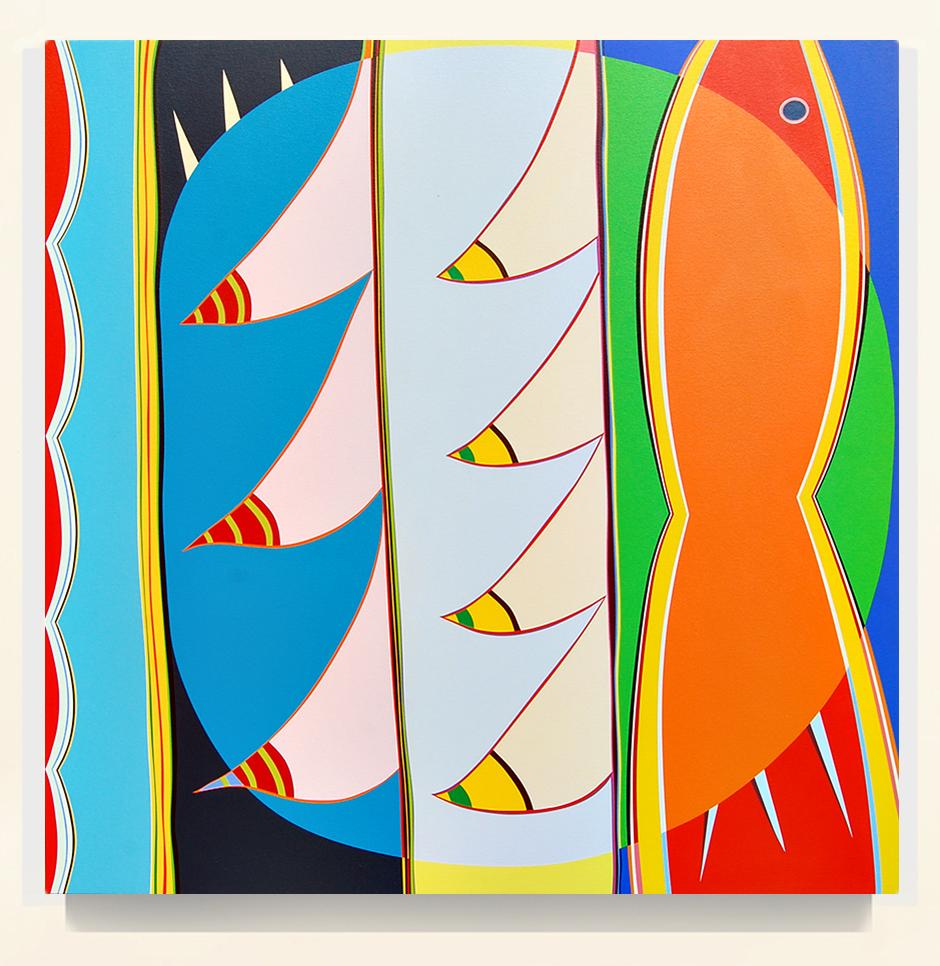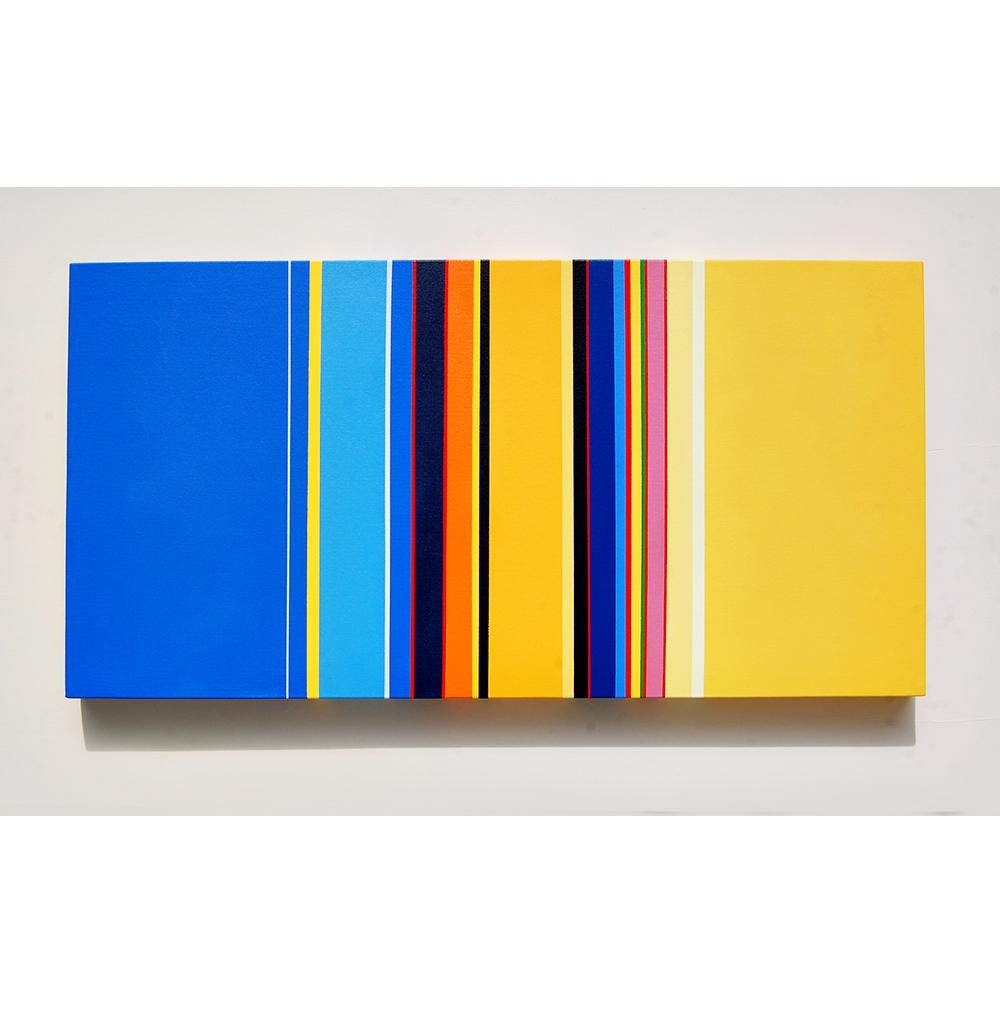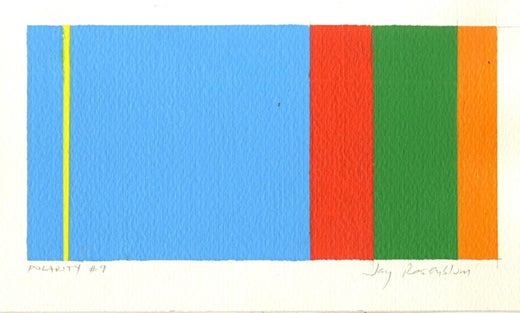Items Similar to "Untitled, " Jay Rosenblum, Hard-Edge Color Field, Colorful Horizontal Stripes
Want more images or videos?
Request additional images or videos from the seller
1 of 7
Jay Rosenblum"Untitled, " Jay Rosenblum, Hard-Edge Color Field, Colorful Horizontal Stripes1973
1973
About the Item
Jay Rosenblum (1933 - 1989)
Untitled, 1973
Acrylic on canvas
54 x 128 inches
Signed twice and dated on the reverse
Provenance:
Private Collection, Long Island
Jay Rosenblum experimented with different versions of the "Visual Stripe motif" for more than thirty years. In the 1960's he developed a "hard-edge" style with "flat curtain forms" which had a clearly defined vertical emphasis. These colors as in our example move up and down the picture plane. Space is defined by shifts in color passages. As the artist explained in his own words:
"The vertical forms in my work serve as the vehicle for color and also become a dramatic means of achieving movement and deep space. This becomes possible through a great variation in the stripe thickness and the sudden emergence or disappearance of a particular band of color when it overlaps another."
Rosenblum was an ardent violinist who played for the Seventh Army Symphony in West Germany and who was also an art teacher at the School of Visual Arts. In his art Rosenblum sought to associate his great love for chamber music sonatas with his freely evolving vertical stripes of color. Rosenblum once stated:
"When these elements engage themselves in the painting, there is a great visual excitement for me. A kinship with music, in a polyphonic sense, is very strong in that simultaneously one hears lines of "overlapping" music. In some mysterious way the composer can achieve this and it is equally mysterious and effective in painting when it happens."
In much the same way that singular notes strung together create music, individual stripes of color together can be transformed into a complete art form. He thus viewed these blocks of color almost as separate notes in a piece of music that that when brought together would be transformed into a cohesive unit, resonating with a playfulness that added interest and energy to the picture. With colors Rosenblum attempted to select ones that when juxtaposed against or near one another would become "an exciting visual discovery". He would refer to such works as "free association color development". Rosenblum executed a number of these "hard-edge" paintings which included groupings of color clusters in both vertical and diagonal motifs.
Jay Rosenblum was born in New York City in 1933. He attended the Pratt Institute in Brooklyn from 1951-53, Harvard University in the summer of 1953 and Bard College in Annandale-on-Hudson, NY 1953-1955. He received a M.F.A. from Cranbrook Academy of Art in Bloomfield Hills, MI. His paintings have appeared in numerous selected solo and group exhibitions in the USA and Italy. Rosenblum was awarded the Carlos Lopez Memorial Prize in painting from the Detroit Institute of Art in Detroit, Michigan in 1955 and the Painter of the Year Award from Larry Aldrich, Ridgefield, CT in 1970. He lived and worked in Manhattan for most of his life and sadly died in a tragic bicycle accident in 1989.
- Creator:Jay Rosenblum (1933, American)
- Creation Year:1973
- Dimensions:Height: 54 in (137.16 cm)Width: 128 in (325.12 cm)
- Medium:
- Movement & Style:
- Period:
- Condition:
- Gallery Location:New York, NY
- Reference Number:1stDibs: LU184129930852
Jay Rosenblum
Jay Rosenblum experimented with different versions of the "Visual Stripe motif" for more than thirty years. In the 1960's he developed a "hard-edge" style with "flat curtain forms" which had a clearly defined vertical emphasis. These colors as in our example move up and down the picture plane. Space is defined by shifts in color passages. As the artist explained in his own words: "The vertical forms in my work serve as the vehicle for color and also become a dramatic means of achieving movement and deep space. This becomes possible through a great variation in the stripe thickness and the sudden emergence or disappearance of a particular band of color when it overlaps another." Rosenblum was an ardent violinist who played for the Seventh Army Symphony in West Germany and who was also an art teacher at the School of Visual Arts. In his art Rosenblum sought to associate his great love for chamber music sonatas with his freely evolving vertical stripes of color. Rosenblum once stated: "When these elements engage themselves in the painting, there is a great visual excitement for me. A kinship with music, in a polyphonic sense, is very strong in that simultaneously one hears lines of "overlapping" music. In some mysterious way the composer can achieve this and it is equally mysterious and effective in painting when it happens." In much the same way that singular notes strung together create music, individual stripes of color together can be transformed into a complete art form. He thus viewed these blocks of color almost as separate notes in a piece of music that that when brought together would be transformed into a cohesive unit, resonating with a playfulness that added interest and energy to the picture. With colors Rosenblum attempted to select ones that when juxtaposed against or near one another would become "an exciting visual discovery". He would refer to such works as "free association color development". Rosenblum executed a number of these "hard-edge" paintings which included groupings of color clusters in both vertical and diagonal motifs. Jay Rosenblum was born in New York City in 1933. He attended the Pratt Institute in Brooklyn from 1951-53, Harvard University in the summer of 1953 and Bard College in Annandale-on-Hudson, NY 1953-1955. He received a M.F.A. from Cranbrook Academy of Art in Bloomfield Hills, MI. His paintings have appeared in numerous selected solo and group exhibitions in the USA and Italy. Rosenblum was awarded the Carlos Lopez Memorial Prize in painting from the Detroit Institute of Art in Detroit, Michigan in 1955 and the Painter of the Year Award from Larry Aldrich, Ridgefield, CT in 1970. He lived and worked in Manhattan for most of his life and sadly died in a tragic bicycle accident in 1989.
About the Seller
5.0
Platinum Seller
These expertly vetted sellers are 1stDibs' most experienced sellers and are rated highest by our customers.
Established in 2021
1stDibs seller since 2022
61 sales on 1stDibs
Typical response time: 1 hour
- ShippingRetrieving quote...Ships From: New York, NY
- Return PolicyA return for this item may be initiated within 3 days of delivery.
More From This SellerView All
- "The Secrets in the Circle, " Oli Sihvonen, Blue and Red Hard-Edge GeometricLocated in New York, NYOli T. Sihvonen (1921 - 1991) The Secrets in the Circle, 1962 Oil on canvas 25 x 34 in Signed lower right; signed, titled dated, and inscribed "Box 563 Taos, N.M." on the reverse Provenance: Private Collection, Nyack, New York Known for large, hard-edged abstractions, Oli T. Sihvonen, a Brooklyn native of Finnish ancestry, grew up in Connecticut. He attended the Norwich Art School before enrolling at the Art Students League in New York between 1938 and 1941. During World War II, Sihvonen served in the United States Army as a sergeant, specializing, as he later said, in “camouflage and deception.” His tour of duty took him to Europe where he encountered the work of Paul Cézanne. In the summer of 1946, Sihvonen traveled to western North Carolina to study at Black Mountain College, which experienced a boost in enrollment following the war years. He was greatly influenced by the progressive color theories of Josef Albers, and, later, the thinking of Buckminster Fuller. After leaving Black Mountain in 1948, Sihvonen continued his studies under the G.I. Bill at Louis Ribak’s Taos Valley Art School in New Mexico from 1949 to 1950. A year spent painting murals in Mexico included work for the Instituto Politécnico Nacional in Mexico City, an early example of his large-scale proficiency. Returning to the East Coast, Sihvonen held a succession of teaching posts: initially in Washington, DC, and then in New York City, first at Hunter College in 1954 and the following academic year at Cooper Union. Drawn to the southwestern landscape, Sihvonen moved to New Mexico, where he resided in Taos from 1956 through 1967. There, he painted sizeable geometric compositions with exuberant colors, which was atypical of Taos painters...Category
1960s Hard-Edge Abstract Paintings
MaterialsCanvas, Oil
- "Untitled" Dan Christensen, Geometric Plaid Series, Orange and Blue AbstractBy Dan ChristensenLocated in New York, NYDan Christensen Untitled, circa 1970-71 Acrylic and enamel on canvas 44 x 20 inches Provenance: The artist Sherron Francis (gift from the above) Dan Christensen was an American abs...Category
1970s Abstract Geometric Abstract Paintings
MaterialsEnamel
- "Untitled" Sherron Francis, Female Abstract Expressionism, Red Green Color FieldBy Sherron FrancisLocated in New York, NYSherron Francis Untitled, circa 1975 Acrylic on canvas 90 x 64 inches Artists such as Helen Frankenthaler, Morris Louis, Dan Christensen, and Sam Francis are already well-known name...Category
1970s Abstract Expressionist Abstract Paintings
MaterialsCanvas, Acrylic
- "Untitled" Sherron Francis, Female Abstract Expressionism, Blue Red Color FieldBy Sherron FrancisLocated in New York, NYSherron Francis Untitled, 1975 Acrylic on canvas 96 x 66 inches Artists such as Helen Frankenthaler, Morris Louis, Dan Christensen, and Sam Francis are already well-known names. How...Category
1970s Abstract Expressionist Abstract Paintings
MaterialsCanvas, Acrylic
- "Black Whole, " Jay Rosenblum, Color Field Abstract with StripesBy Jay RosenblumLocated in New York, NYJay Rosenblum Black Whole Signed and titled on the reverse Acrylic on canvas 18 x 32 inches Jay Rosenblum experimented with different versions of the "Visual Stripe motif" for more ...Category
1970s Abstract Abstract Paintings
MaterialsCanvas, Acrylic
- "Ouverture, with Cypress Forms" Stephen Edlich, Abstract Geometric PaintingBy Stephen EdlichLocated in New York, NYStephen Edlich Ouverture, with Cypress Forms, 1982 Signed, dated and titled on the stretcher Acrylic paint, mixed media, and burlap on canvas 60 x 40 inches An artist who worked in the post-cubist and constructivist traditions, Stephen P. Edlich gained a considerable amount of acclaim in the 1970s and 1980s for his collages, sculpture, and paintings. His promising career was cut short due to his untimely death at age 45 in 1989. Edlich was born in New York City. He received his undergraduate degree with a major in fine arts studies from New York University in 1967. During his college years, he traveled to London, where he met the art dealer Victor Waddington and created his first white on white collage. In that same year, he attended a major exhibition of the work of Ben Nicholson, which would be influential source in his art. Edlich returned to England in 1967, where he met Barbara Hepworth and Patrick Heron in London and traveled to St. Ives, Cornwall, long a favorite artists' haunt. Edlich began creating acrylic reliefs...Category
1980s Abstract Geometric Abstract Paintings
MaterialsCanvas, Burlap, Mixed Media, Acrylic
You May Also Like
- "Naxos" Painting - Hard edge, color bomb, bold, blue, green, orange redBy Kurt HerrmannLocated in Marmora, NJ"I want the Color Bombs to be beacons of positivity that can radiate across the room or whisper quietly beside you. I love the freedom and openness of color. These works don’t bring ...Category
2010s Hard-Edge Abstract Paintings
MaterialsCanvas, Acrylic
- "Pollinator No.2" Painting - Hard edge, color bomb, bold, pink, blue, orangeBy Kurt HerrmannLocated in Marmora, NJ"I want the Color Bombs to be beacons of positivity that can radiate across the room or whisper quietly beside you. I love the freedom and openness of color. These works don’t bring ...Category
2010s Hard-Edge Abstract Paintings
MaterialsCanvas, Acrylic
- "Pollinator No.1" Painting - Hard edge, color bomb, bold, yellow, green, blueBy Kurt HerrmannLocated in Marmora, NJ"I want the Color Bombs to be beacons of positivity that can radiate across the room or whisper quietly beside you. I love the freedom and openness of color. These works don’t bring ...Category
2010s Hard-Edge Abstract Paintings
MaterialsCanvas, Acrylic
- "The Bee Keeper’s Wife" Acrylic/Canvas - Hard edge, color bomb, blue, yellowBy Kurt HerrmannLocated in Marmora, NJ"The Bee Keeper’s Wife" Acrylic on canvas 30"x58” (76x147 cm) This Color Bomb was a direct reaction to an intense stretch of summer weather in the Appalachian mountains...Category
2010s Hard-Edge Abstract Paintings
MaterialsCanvas, Acrylic
- "Gold Rush" Painting - Hard edge, color bomb, bold, blue, green, orangeBy Kurt HerrmannLocated in Marmora, NJ"I want the Color Bombs to be beacons of positivity that can radiate across the room or whisper quietly beside you. I love the freedom and openness of color. These works don’t bring ...Category
2010s Hard-Edge Abstract Paintings
MaterialsCanvas, Acrylic
- "Praying Mantis" Painting - Hard edge, color bomb, bold, blue, green, orangeBy Kurt HerrmannLocated in Marmora, NJ"I want the Color Bombs to be beacons of positivity that can radiate across the room or whisper quietly beside you. I love the freedom and openness of color. These works don’t bring ...Category
2010s Hard-Edge Abstract Paintings
MaterialsCanvas, Acrylic






